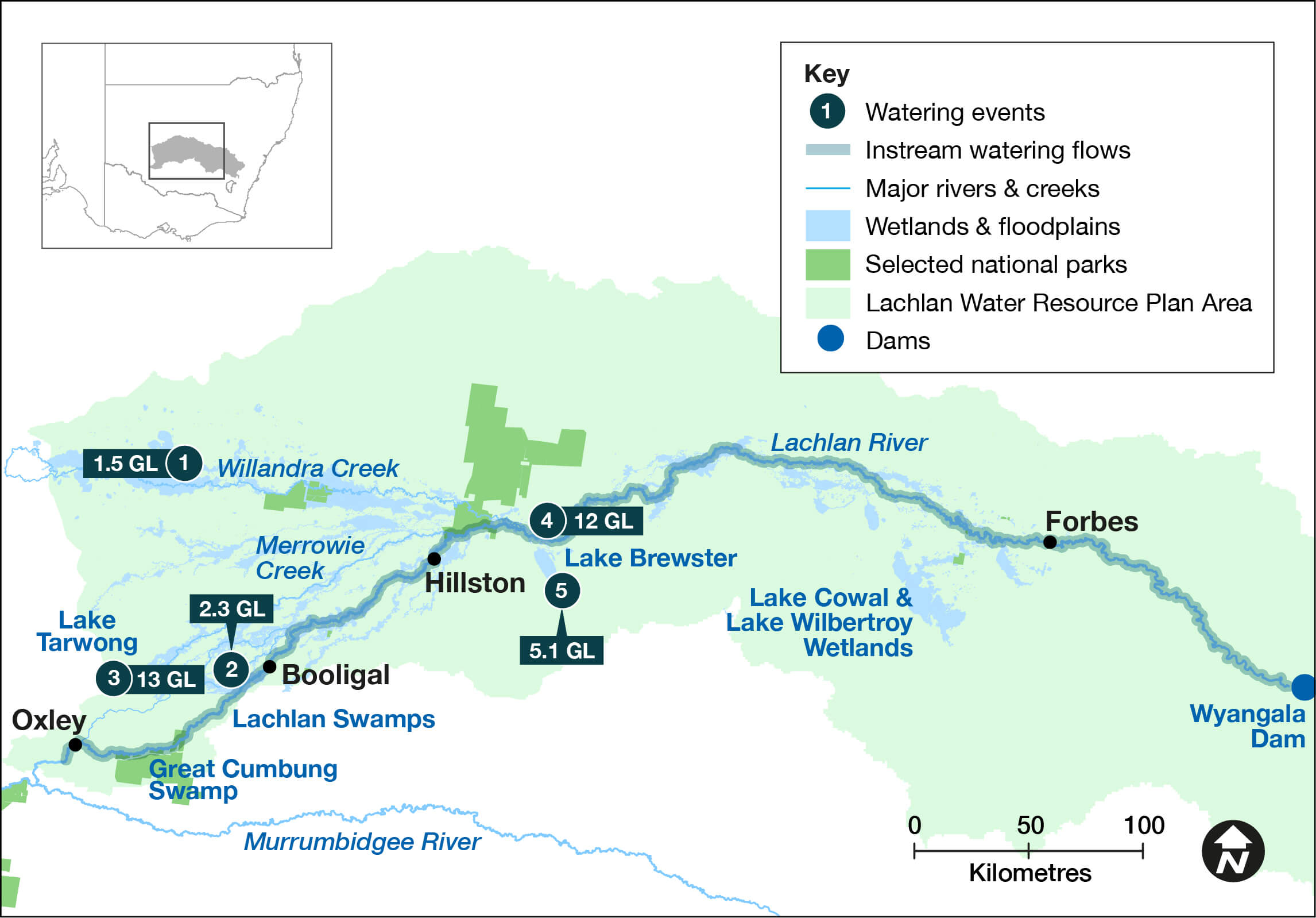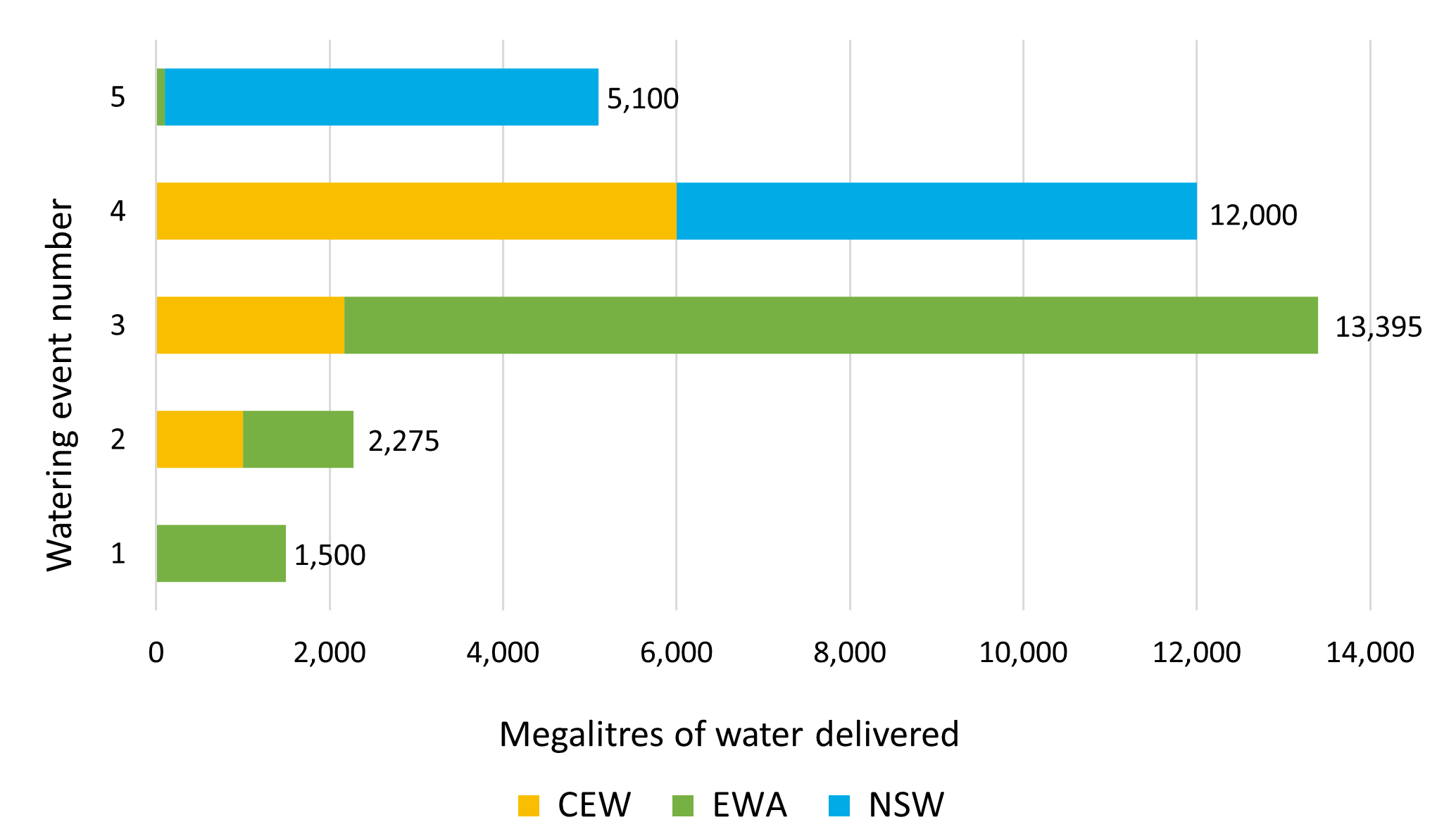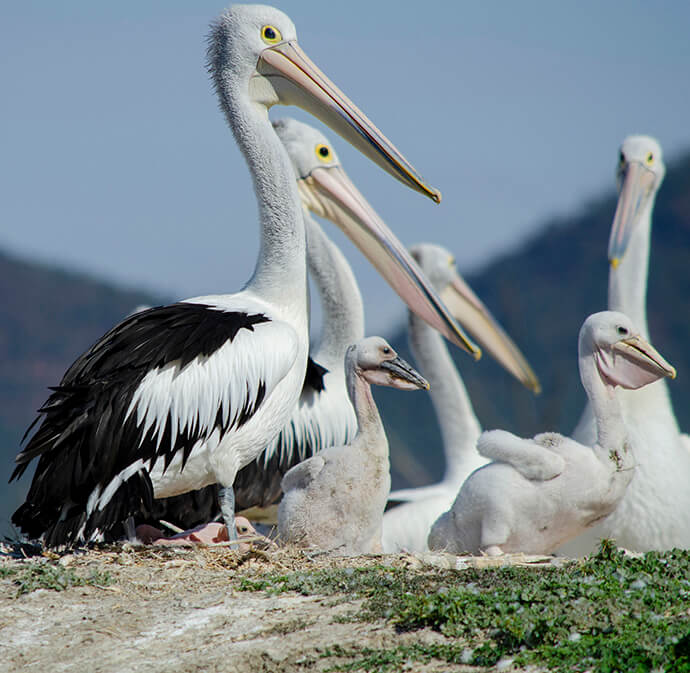Catchment connectivity, waterbird breeding and native plants were the focus of environmental flows in the Lachlan in 2021–22.
Key outcomes
Under very wet conditions, environmental water managers worked with partner agencies and stakeholders to coordinate the delivery of water for the environment to:
- support more than 15,000 Australian pelican nests to completion
- enhance natural ecosystem functions from wet catchment conditions by supplementing other flows to maintain connectivity across the extensive lower Lachlan floodplain, including Willandra Creek
- contribute to inundation along the length of Merrowie Creek, including the prolonged inundation of Lake Tarwong to improve vegetation condition
- restore a more natural flooding regime to Box Creek below Lake Tarwong, inundating fringing black box and river cooba creek corridors and wetlands for the first time since 2016.
Catchment conditions
During the 2021–22 year the Lachlan catchment experienced very wet La Niña weather conditions, with rainfall in some parts of the catchment breaking records. Inflows into Wyangala Dam led to the full 350,000 megalitres (ML) of translucent flow delivered past Lake Brewster Weir from July to September 2021. Wyangala Dam remained under flood management operations for the remainder of the water year.
Wyangala Dam spilled in September 2021 and again in March 2022, with general security entitlements reset at 115% and 121%, respectively. As a result, the Lachlan River and creek systems ran high for most of the water year and connected to riparian and floodplain wetlands for durations not seen in decades.
Water for the environment was managed primarily to extend the duration, depth and lateral connectivity of floodplain inundation in the lower Lachlan distributary creeks and to support colonial waterbird breeding.
About the catchment
The Lachlan catchment is in central western New South Wales, covering an area of 90,000 square kilometres. Climatic zones of the Lachlan catchment vary markedly as it flows from the headwaters and tablelands in the east through the slopes of the middle catchment, to the flat, western plains.
The major river is the Lachlan with nearly 1,300 kilometres of the 1,400-kilometre river regulated by water storages, of which Wyangala Dam is the largest at 1,220 gigalitres (GL). It starts as a chain of ponds near Gunning and ends in the Great Cumbung Swamp, only flowing through to the Murrumbidgee when both rivers are in flood.
The Lachlan catchment is characterised by alluvial floodplains and distributary creek systems. It maintains some of the most diverse assemblages of wetland habitats, some only found in this catchment. Important sites include the Booligal Wetlands, Lake Brewster, Lake Cowal, Great Cumbung Swamp and Lachlan Swamps, all of which are listed in the Directory of Important Wetlands in Australia.
Traditional owners
The Lachlan is Country to the Wiradjuri, Nari Nari, Mutthi Mutthi, Ngiyampaa and Yita Yita First Nations.
Watering aims
Under a moderate to wet resource availability scenario, the Lachlan Environmental Water Advisory Group developed its Lachlan Catchment – Water for the Environment: Annual Priorities 2021–22. Aims for the use of water for the environment were to:
- extend inundation of river red gum, black box and lignum floodplain wetlands in the lower Lachlan distributary creeks (Willandra, Merrowie and Merrimajeel creeks)
- provide high-quality habitat for waterbird breeding, foraging and dispersal
- support colonial waterbird breeding events at multiple rookery sites as they occur
- extend longitudinal and lateral connectivity from translucent or tributary flows in the Lachlan Swamps and Great Cumbung region
- promote seed setting and establish inflow wetland at Lake Brewster.
With very wet conditions across the catchment, environmental water managers used adaptive management strategies to restore key floodplain and wetland connections and enhanced opportunities for plants and animals to breed, move and thrive.
Water delivery
This table and chart provide a summary of 34,270 megalitres of water for the environment delivered in the Lachlan catchment during the 2021–22 watering year. A further 350,000 megalitres of translucent flows were also delivered. Figures are accurate at the date of publishing, but maybe adjusted. Watering event numbers in the table and bar chart relate to location numbers marked on the map.
Notes: CEW = Commonwealth licensed environmental water; EWA = environmental water allowance accrued under the Water Sharing Plan; NSW = NSW licensed environmental water; TLM = The Living Murray.
| Watering event number | Location | Outcomes | Start date | Finish date |
|---|---|---|---|---|
| 1 | Willandra–Morrison’s lake | Waterbirds Vegetation | 1 Jul 2021 | 30 Jul 2021 |
| 2 | Merrimajeel to Angora | Vegetation | 1 Jul 2021 | 21 Sep 2021 |
| 3 | Merrowie–Tarwong and Box Creek | Vegetation | 1 Jul 2021 | 21 Aug 2021 |
| 4 | Merrowie–Tarwong and Box Creek | Vegetation | 8 Apr 2022 | 29 Jun 2022 |
| 5 | Post translucent floodplain inundation | Connectivity | 9 Jul 2021 | 29 Jul 2021 |
| 6 | Lake Brewster pelicans | Waterbirds | 17 Feb 2022 | 30 Apr 2022 |
Outcomes
In 2021–22 NSW environmental water managers worked with the Commonwealth Environmental Water Holder (CEWH), stakeholders and the community to deliver 6 watering actions across the catchment:
- To maintain winter inflows to one of the Lachlan’s 3 unique river red gum–lignum floodplain wetlands, Murrumbidgil Swamp. This was done in partnership with Merrimajeel Creek District Trust landholders and the CEWH. Long-term monitoring shows that targeted repeat watering since 2011 has contributed to significant improvement in the condition of the wetland vegetation.
- To provide ideal breeding conditions for the largest Australian pelican breeding event on record at Lake Brewster. More than 15,000 nests were monitored for 7 months. This event was managed in partnership with Water NSW and the CEWH.
- To maintain continual flow through more than 250 kilometres of creek habitat to inundate Box Creek wetlands, including Chillichil Swamp for first time since 2016. Lignum shrublands in lower Merrowie Creek are now recovering, small-scale colonial waterbird breeding has returned to Lake Tarwong, and ephemeral floodplain wetlands are flush with productivity. All will provide high-quality floodplain habitat for waterbirds in spring–summer 2022. This event was conducted in collaboration with Merrowie Creek landholders.
- To contribute to flows in Willandra Creek to fill Morrison’s Lake and enhance connectivity to end-of-system lignum shrublands and black box woodland. This flow provided habitat for waterbirds (threatened species, migratory waders and colonial waterbirds), including good numbers of the vulnerable blue-billed duck and white-bellied sea eagle. Flows also addressed the cultural objectives of the Ngiyampaa Wangaaypuwan Nation as outlined in a consultation report prepared for water resource plans.
Case study: Gulambali boom at Lake Brewster
In 2021–22 more than 30,000 adult pelicans (gulambali) nested at Lake Brewster, the largest breeding event in more than 30 years at the lake.
Lake Brewster is a renowned pelican breeding site as it provides suitable breeding habitat (islands) and abundant food resources, primarily fish. The lake is located in the mid-Lachlan between Lake Cargelligo and Hillston.
Environmental water managers and Water NSW have a long-standing partnership in managing Lake Brewster for water storage and environmental outcomes, such as waterbird breeding events. At Lake Brewster, pelicans nest on the banks of delivery channels in wet seasons. When the lake is full the banks are surrounded by water which helps protect the pelican nests from predation by pest animals. However, water levels need to be managed so that nests are not drowned by high storage levels or high wave action created during storm events.
In 2022 environmental water managers worked with Water NSW to maintain a 103% storage capacity in Lake Brewster from 1 February until 27 May. To maximise storage levels and avoid inundation of pelican nests, not all surplus flows were captured during the breeding period. When the breeding event ended 5,100 megalitres was debited from NSW environmental water accounts as surcharge for storage water that was foregone between February and May.
Monthly monitoring of the pelican colony was conducted to inform future management of the site. Fish were also monitored to better understand food availability needs of the colony. The event also provided an opportunity for us to continue our long-term pelican banding program, a collaboration with the University of NSW, Water NSW and the Lake Cowal Foundation, which aims to increase understanding of nesting habits and site fidelity of the pelicans.
Find out more about Lake Brewster pelican banding.


